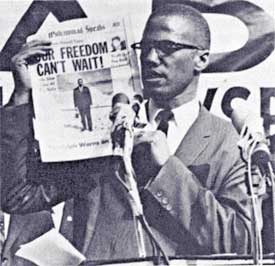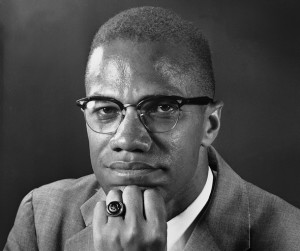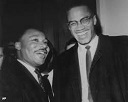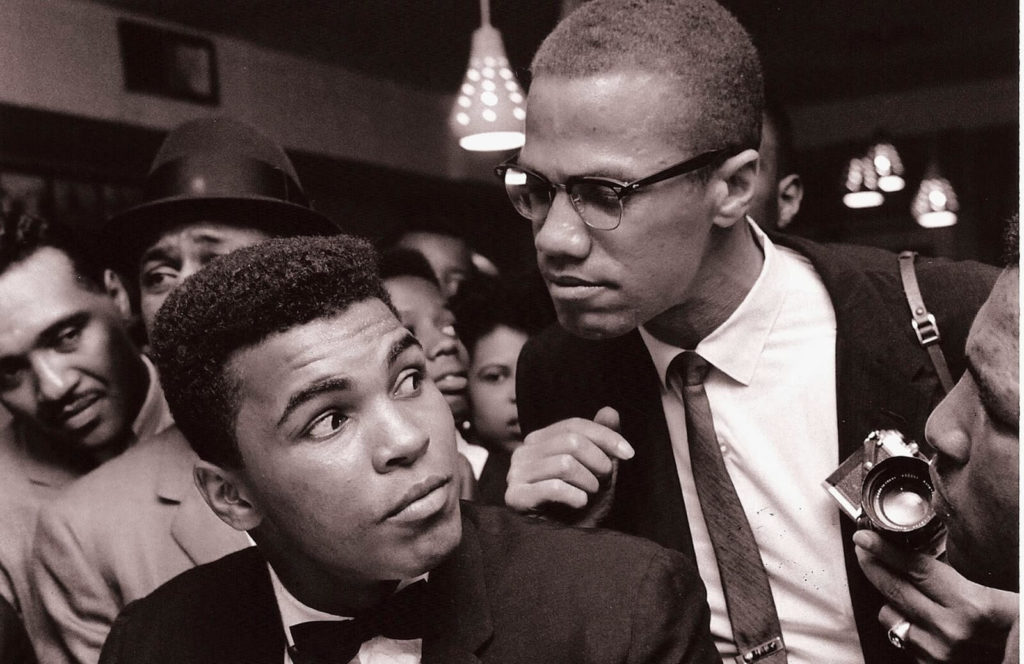Malcolm X (19 May 1925 – 21 Feb 1965)
BIOGRAPHIES, 17 May 2021
Biography – TRANSCEND Media Service
Civil Rights Activist, Minister
African-American leader and prominent figure in the Nation of Islam, Malcolm X articulated concepts of race pride and black nationalism in the 1950s and ’60s.
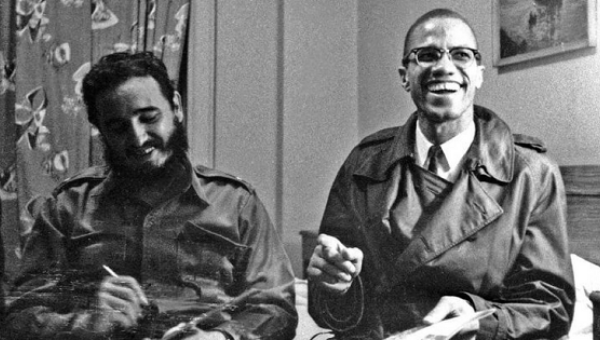
Fidel met Black activist Malcolm X in September 1960 before a U.N. General Assembly meeting. | Photo: Reuters
Born on May 19, 1925, in Omaha, Nebraska, Malcolm X was a prominent black nationalist leader who served as a spokesman for the Nation of Islam during the 1950s and ’60s. Due largely to his efforts, the Nation of Islam grew from a mere 400 members at the time he was released from prison in 1952 to 40,000 members by 1960. Articulate, passionate and a naturally gifted and inspirational orator, Malcolm X exhorted blacks to cast off the shackles of racism “by any means necessary,” including violence. The fiery civil rights leader broke with the group shortly before his assassination, February 21, 1965, at the Audubon Ballroom in Manhattan, where he had been preparing to deliver a speech.
Early Life
Malcolm X was born Malcolm Little on May 19, 1925, in Omaha, Nebraska. Malcolm was the fourth of eight children born to Louise, a homemaker, and Earl Little, a preacher who was also an active member of the local chapter of the Universal Negro Improvement Association and avid supporter of black nationalist leader Marcus Garvey. Due to Earl Little’s civil rights activism, the family faced frequent harassment from white supremacist groups such as the Ku Klux Klan and one of its splinter factions, the Black Legion. In fact, Malcolm X had his first encounter with racism before he was even born.
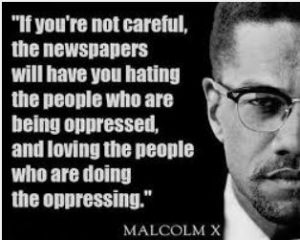 “When my mother was pregnant with me, she told me later, ‘a party of hooded Ku Klux Klan riders galloped up to our home,’” Malcolm later remembered. “Brandishing their shotguns and rifles, they shouted for my father to come out.” The harassment continued; when Malcolm X was four years old, local Klan members smashed all of the family’s windows, causing Earl Little to decide to move the family from Omaha to East Lansing, Michigan.
“When my mother was pregnant with me, she told me later, ‘a party of hooded Ku Klux Klan riders galloped up to our home,’” Malcolm later remembered. “Brandishing their shotguns and rifles, they shouted for my father to come out.” The harassment continued; when Malcolm X was four years old, local Klan members smashed all of the family’s windows, causing Earl Little to decide to move the family from Omaha to East Lansing, Michigan.
However, the racism the family encountered in East Lansing proved even greater than in Omaha. Shortly after the Littles moved in, in 1929, a racist mob set their house on fire, and the town’s all-white emergency responders refused to do anything. “The white police and firemen came and stood around watching as the house burned to the ground,” Malcolm X later remembered.
Two years later, in 1931, things got much, much worse. Earl Little’s dead body was discovered laid out on the municipal streetcar tracks. Although Malcolm X’s father was very likely murdered by white supremacists, from whom he had received frequent death threats, the police officially ruled his death a suicide, thereby voiding the large life insurance policy he had purchased in order to provide for his family in the event of his death. Malcolm X’s mother never recovered from the shock and grief of her husband’s death. In 1937, she was committed to a mental institution and Malcolm X left home to live with family friends.
Malcolm X attended West Junior High School, where he was the school’s only black student. He excelled academically and was well liked by his classmates, who elected him class president. However, he later said that he felt that his classmates treated him more like the class pet than a human being. The turning point in Malcolm X’s childhood came in 1939, when his English teacher asked him what he wanted to be when he grew up and he answered that he wanted to be a lawyer. His teacher responded, “One of life’s first needs is for us to be realistic … you need to think of something you can be … why don’t you plan on carpentry?” Having thus been told in no uncertain terms that there was no point in a black child pursuing education, Malcolm X dropped out of school the following year, at the age of 15.
After quitting school, Malcolm X moved to Boston to live with his older half-sister, Ella, about whom he later recalled, “She was the first really proud black woman I had ever seen in my life. She was plainly proud of her very dark skin. This was unheard of among Negroes in those days.” Ella landed Malcolm a job shining shoes at the Roseland Ballroom. However, out on his own on the streets of Boston, Malcolm X became acquainted with the city’s criminal underground, soon turning to selling drugs. He got another job as kitchen help on the Yankee Clipper train between New York and Boston and fell further into a life of drugs and crime. Sporting flamboyant pinstriped zoot suits, he frequented nightclubs and dance halls and turned more fully to crime to finance his lavish lifestyle. This phase of Malcolm X’s life came to a screeching halt in 1946, when he was arrested on charges of larceny and sentenced to ten years in jail.
To pass the time during his incarceration, Malcolm X read constantly, devouring books from the prison library in an attempt make up for the years of education he had missed by dropping out of high school. Also while in prison, he was visited by several siblings who had joined to the Nation of Islam, a small sect of black Muslims who embraced the ideology of black nationalism—the idea that in order to secure freedom, justice and equality, black Americans needed to establish their own state entirely separate from white Americans. Malcolm X converted to the Nation of Islam while in prison, and upon his release in 1952 he abandoned his surname “Little,” which he considered a relic of slavery, in favor of the surname “X”—a tribute to the unknown name of his African ancestors.
Nation of Islam
Now a free man, Malcolm X traveled to Detroit, Michigan, where he worked with the leader of the Nation of Islam, Elijah Muhammad, to expand the movement’s following among black Americans nationwide. Malcolm X became the minister of Temple No. 7 in Harlem and Temple No. 11 in Boston, while also founding new temples in Harford and Philadelphia. In 1960, he established a national newspaper, Muhammad Speaks, in order to further promote the message of the Nation of Islam.
Articulate, passionate and a naturally gifted and inspirational orator, Malcolm X exhorted blacks to cast off the shackles of racism “by any means necessary,” including violence. “You don’t have a peaceful revolution,” he said. “You don’t have a turn-the-cheek revolution. There’s no such thing as a nonviolent revolution.” Such militant proposals—a violent revolution to establish an independent black nation—won Malcolm X large numbers of followers as well as many fierce critics. Due primarily to the efforts of Malcolm X, the Nation of Islam grew from a mere 400 members at the time he was released from prison in 1952, to 40,000 members by 1960.
By the early 1960s, Malcolm X had emerged as a leading voice of a radicalized wing of the Civil Rights Movement, presenting an alternative to Dr. Martin Luther King Jr.’s vision of a racially integrated society achieved by peaceful means. Dr. King was highly critical of what he viewed as Malcolm X’s destructive demagoguery. “I feel that Malcolm has done himself and our people a great disservice,” King once said.
Philosophical differences with King were one thing; a rupture with Elijah Muhammad proved much more traumatic. In 1963, Malcolm X became deeply disillusioned when he learned that his hero and mentor had violated many of his own teachings, most flagrantly by carrying on many extramarital affairs; Muhammad had, in fact, fathered several children out of wedlock. Malcolm’s feelings of betrayal, combined with Muhammad’s anger over Malcolm’s insensitive comments regarding the assassination of President John F. Kennedy, led Malcolm X to leave the Nation of Islam in 1964.
That same year, Malcolm X embarked on an extended trip through North Africa and the Middle East. The journey proved to be both a political and spiritual turning point in his life. He learned to place the American Civil Rights Movement within the context of a global anti-colonial struggle, embracing socialism and pan-Africanism. Malcolm X also made the Hajj, the traditional Muslim pilgrimage to Mecca, Saudi Arabia, during which he converted to traditional Islam and again changed his name, this time to El-Hajj Malik El-Shabazz.
After his epiphany at Mecca, Malcolm X returned to the United States less angry and more optimistic about the prospects for peaceful resolution to America’s race problems. “The true brotherhood I had seen had influenced me to recognize that anger can blind human vision,” he said. “America is the first country … that can actually have a bloodless revolution.” Tragically, just as Malcolm X appeared to be embarking on an ideological transformation with the potential to dramatically alter the course of the Civil Rights Movement, he was assassinated.
Death and Legacy
On the evening of February 21, 1965, at the Audubon Ballroom in Manhattan, where Malcolm X was about to deliver a speech, three gunmen rushed the stage and shot him 15 times at point blank range. Malcolm X was pronounced dead on arrival at Columbia Presbyterian Hospital shortly thereafter. He was 39 years old. The three men convicted of the assassination of Malcolm X were all members of the Nation of Islam: Talmadge Hayer, Norman 3X Butler and Thomas 15X Johnson.
In the immediate aftermath of Malcolm X’s death, commentators largely ignored his recent spiritual and political transformation and criticized him as a violent rabble-rouser. However, Malcolm X’s legacy as a civil rights hero was cemented by the posthumous publication in 1965 of The Autobiography of Malcolm X: As Told to Alex Haley. At once a harrowing chronicle of American racism, an unsparing self-criticism and an inspiring spiritual journey, the book, transcribed by the acclaimed author of Roots, instantly recast Malcolm X as one of the great political and spiritual leaders of modern times. Named by TIME magazine one of 10 “required reading” non-fiction books of all-time, The Autobiography of Malcolm X has truly enshrined Malcolm X as a hero to subsequent generations of radicals and activists.
Perhaps Malcolm X’s greatest contribution to society was underscoring the value of a truly free populace by demonstrating the great lengths to which human beings will go to secure their freedom. “Power in defense of freedom is greater than power in behalf of tyranny and oppression,” he stated. “Because power, real power, comes from our conviction which produces action, uncompromising action.”
Personal Life
In 1958, Malcolm X married Betty Sanders, a fellow member of the Nation of Islam. The couple had six children together, all daughters: Attallah (b. 1958), Qubilah (b. 1960), Ilyasah (b. 1963), Gamilah (b. 1964) and twins Malaak and Malikah (b. 1965). Sanders later became known as Betty Shabazz, and she became a prominent civil rights and human rights activist in her own right in the aftermath of her husband’s death.
In May 2013, Malcolm X’s grandson, Malcolm Shabazz—son of the civil rights leader’s second daughter with wife Betty Shabazz, Qubilah Shabazz—was beaten to death in Mexico City, near the Plaza Garibaldi. He was 28 years old. According to a report by the Los Angeles Times, police believe Malcolm Shabazz’s death was the result of a “robbery gone wrong.”
Go to Original – biography.com
Tags: Activism, Anglo America, Biography, Civil Rights, History, Malcolm X, Nation of Islam, USA
DISCLAIMER: The statements, views and opinions expressed in pieces republished here are solely those of the authors and do not necessarily represent those of TMS. In accordance with title 17 U.S.C. section 107, this material is distributed without profit to those who have expressed a prior interest in receiving the included information for research and educational purposes. TMS has no affiliation whatsoever with the originator of this article nor is TMS endorsed or sponsored by the originator. “GO TO ORIGINAL” links are provided as a convenience to our readers and allow for verification of authenticity. However, as originating pages are often updated by their originating host sites, the versions posted may not match the versions our readers view when clicking the “GO TO ORIGINAL” links. This site contains copyrighted material the use of which has not always been specifically authorized by the copyright owner. We are making such material available in our efforts to advance understanding of environmental, political, human rights, economic, democracy, scientific, and social justice issues, etc. We believe this constitutes a ‘fair use’ of any such copyrighted material as provided for in section 107 of the US Copyright Law. In accordance with Title 17 U.S.C. Section 107, the material on this site is distributed without profit to those who have expressed a prior interest in receiving the included information for research and educational purposes. For more information go to: http://www.law.cornell.edu/uscode/17/107.shtml. If you wish to use copyrighted material from this site for purposes of your own that go beyond ‘fair use’, you must obtain permission from the copyright owner.
